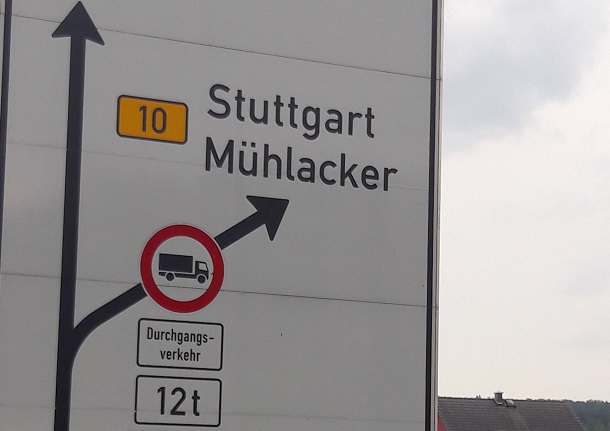Urban Access Regulations are implemented by cities to improve the city or town in some way. Not every scheme has been assessed in a quantitative way, assessments of Dublin, Athens and German lorry transit bans are given below.

Dublin
German lorry transit bans
Athens
Studded road tyre charges in Norway
Dublin introduced a HGV (Heavy Goods Vehicle) Management strategy on the opening of a harbour tunnel (Dublin Port Tunnel, DPT) in February 2007. It bans 5+ axle vehicles during the hours of 07.00-19.00, seven days a week from a designated cordon area and provides a limited permit scheme for 5+ axle vehicles that need to load/unload within the city centre area. There is a reduced amount for Eastlink toll for affected vehicles.
The scheme is well described on Dublin's city website, and they have manuals and other help for vehicle operators to complete the forms.
The objectives of the scheme were:
- maximising the use of the and minimising use of the city streets by HGVs travelling to/from Dublin Port,
- to minimize the conflicts between delivery and service requirements of businesses and the needs of all other road users.
- managing, for a limited period, the small number of ‘over height’ HGVs, that cannot use the DPT on the city’s streets and
- managing diverted HGVs under partial or full DPT closure conditions.
The lorry Management Strategy was reviewed in 2009 and had resulted in dramatic reductions of 5+ axle vehicles within the city centre area of between 88-96%. This is reflected in the fact that over 3,582 5+ axle vehicles used the tunnel per day in 2009. The number of permits which Dublin City Council now issue, of both load/unload and Transit, is now in the order of 90 per day for the cordon area.
By removing 5+ axle vehicles from the city centre the HGV Management Strategy has:
- improved the daily lives of people who live and work in the city centre by reducing both noise and pollution levels.
- made city streets safer for pedestrians, cyclists and other vulnerable road users. According to the 2008 canal cordon count (Nov 07- Nov 08) there has been an 8% increase in the number of cyclists crossing the canal cordon in the morning peak and recent figures from College Green show a 30% plus of cyclists.
- made it possible to reallocate valuable road space to Public Transport, an example of this is the Bus Lane along the North Quays at Arran Quay.
The change on roads has been dramatic with the numbers of HGVs now on East Wall Road where the reduction has been 97.5% during the cordon hours and 97% over 24 hours. The numbers now using this road per month in 2009 are now less than the number of trucks that used it per day in 2006.
More details are available from Dublin citys HGV page
A number of German cities implement lorry transit bans, such as Bonn or Frankfurt, to reduce emissions and traffic in the city, from lorries that do not need to enter the city. The German Environment Agency (UBA) has published a report in English estimating the impact of these measures, and all other measures to reduce emissions used in Germany. The reduction potential strongly depends on the proportion of lorries in the traffic flow, as well as how well the measure is enforced and compliance rates. Maximum emissions reduction potentials are given as 20% for NOx, 10% for NO2, 10% for PM10 and 7% for black soot. Calculated for different cities for different dates and compliances the theoretical reduction potentials ranged from 1.2% to 16.7%
Athens has run an odd-even scheme since 1982, with the aim of reducing congestion. It is now having LEZ aspects added – the odd-even scheme does not need to be obeyed by any cleaner vehicles.
The impact of the scheme is well set out in this quote from a 2001 study: “The initial expectations of the government, regarding the effectiveness of the scheme, have been principally fulfilled. The implementation of the city cordon has been satisfactory at the beginning. The traffic has been controlled much more efficiently than before and air pollution measurements showed significantly lower emissions. The efficiency of the new policy though, was soon to be undermined, because of drivers who tried to overcome the restraints by several methods. Significant increased double-car ownership, induced car use on allowed days, exemptions (special licences for journalists, state officials), some violations, and increased use of taxis (unofficially shared) and motorcycles are some well-established facts and developments of the past fifteen years, and are believed to amount to a severe reduction in the effectiveness of the inner circle.” The number of two car households has also increased in many European countries since the 1980s, when two-car households were rarer. In Athens in 2001 car ownership varies from 0.61 passenger cars per household in the central area, up to 1.16 cars/household in richer the northeastern suburbs.
Studded road tyre charges in Norway
Studded tyres are used by some vehicle operators in some northern countries. Under some circumstances they can give better traction, however the development of better tyres and the clearing of snow in urban areas make them less relevant today. The problem with studded tyres is that they harm the road surface. This means that not only the road needs to be more regularly replaced, but this is the source of a significant amount of the harmful PM10 emissions in some Scandinavian countries. Hence measures are being implemented to reduce their use.
In many countries studded tyres are forbidden. The Norwegian studded tyre fee allows studded tyres to be used, but discourages their use in cities.
The scheme has been successful in decreasing the proportion of studded tyres by 30-40%. In Oslo and Bergen, where the scheme is in place, there is a 15% use of studded tyres. In Stockholm (where use is forbidden on a single street) the usage is 50-70%.


